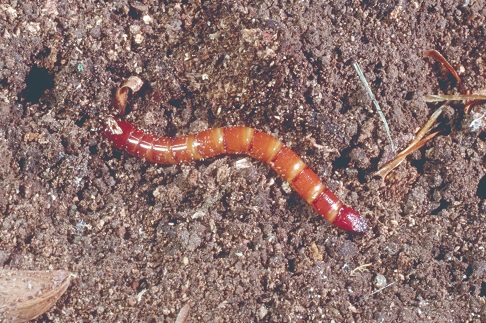Soil Insect Pests and Returning Idle Land to Production
ENTFACT-122: Soil Insect Pests and Returning Idle Land to Production | Download PDF
by Lee Townsend, Ric Bessin, and Doug Johnson, Extension Specialists
University of Kentucky College of Agriculture
Field history is the key factor to use in determining potential soil insect problems. The type and numbers of soil insects that can thrive depends upon the vegetation present in previous years. Plant characteristics, such as leaf color, odor or pollen, can attract certain insects. These may feed on plants and lay their eggs in the soil so that their immature stages can feed on the roots. Some insects feed upon only a few types of plants; others will eat a variety. The greater the diversity of plants (grasses and broad-leaved species) in a field, the more different types of soil insects that will be found there. However, there should be relatively small numbers of many different kinds of insects; no one group should be favored. A field with a relatively pure stand will have greater numbers of a few types or species.
The longer a particular type of vegetation is present, the greater the opportunity for specific insects to increase in numbers. Ten years of grass or grass and broad-leaf cover on idle land provides a very stable situation. They may occur over the entire field or only in specific areas. Fortunately, most acreage not in production has been seeded in fescue. Few soil insects build up in large numbers in relatively pure fescue sod. Over many years, UK research and demonstration plots have shown very low numbers of soil insects associated with fescue.
Potential Soil Insect Problems
White grubs, wireworms, and corn root aphids can reduce crop stands or slow early growth. However, recent research and demonstration plots on idle land returning to production in Kentucky have shown soil insects to be below damaging numbers. The potential for problems with soil insects in fields with strong, vigorous stands of fescue is very low.
Grain sorghum, soybeans or wheat have few problems with soil insects so they are excellent crops in fields where problems are anticipated. Corn is more susceptible to damage by wireworms, white grubs, and corn root aphids. If factors favor corn production, then an at- planting application of a granular soil insecticide is recommended for weedy or non-fescue fields. Dock and plantain are good host plants for corn root aphids, an abundance of them in a field increases the potential for these pests. Corn root aphid numbers can be reduced by some granular soil insecticides. There are no “rescue” treatments for soil insects once damage has been found. Careful selection of a crop and the use of a preventive treatment, when necessary, is the best strategy.
Wireworms
Bait stations for wireworms or digging soil cores to look for white grubs are ways to get an idea of soil insect pressure in a field before planting. Bait stations, which are really solar traps, are made by digging a hole 4 inches deep and about 9 inches wide. You will need to place 1/2 cup of untreated corn-wheat mixture in the bottom of the hole. The hole is then filled with loose dirt. Do not pack the dirt. The area should then be covered with plastic. Gases produced by the breakdown of the corn-wheat mixture will attract wireworms to the station.
Figure 1. Wireworms can be common pests when returning land to row crops.
Stations should be set at least 3 weeks before your planned planting date. The stations are checked in two weeks by digging up the bait and searching through the seeds for wireworms. If you find one or more wireworms per bait station, use a soil insecticide or insecticide seed treatment at planting. Rescue treatments after damage is visible are not effective. If damage is sufficient to justify replanting, a soil insecticide should be applied during replanting.
Seedcorn Maggot
Seedcorn maggot can severely reduce stands in fields with a substantial cover of crop residue. With this insect, planting in well prepared seedbeds, planted sufficiently late for quick germination is one means for reducing injury. Where possible, heavy cover crops should be turned over early to render the field less attractive to egg laying seedcorn maggot flies in the spring. Shallow planting will increase germination rates and aid in speeding up germination and reduce losses to seedcorn maggots.
Cutworms
Idle land is not more prone to cutworm problems than land that has been continuously in production. However, the amount of weediness, cover-crop surface residue, and the type of tillage used will determine, in part, the potential for cutworms. While reduced tillage is encouraged for soil and energy conservation, fields using these practices tend to have higher levels of weeds and decaying organic matter. The increased crop residue and weediness of reduced tillage fields may place these at a higher risk for infestation than conventional tillage fields by encouraging cutworm egg-laying.
Figure 2. Black cutworm is one of the more common cutworm pests.
Cultivation and other weed-control programs used after a cutworm population has established itself will force the cutworms to feed on seedling crops. Producers need to allow at least two weeks between weed control and planting to order to reduce cutworm numbers prior to seedling emergence.
Need for Insecticides
Routine application of a soil insecticide for corn grown on previously idle land is not justified in the vast majority of cases. Insecticide seed treatments are recommended to protect corn and soybeans from attack by seed maggots.
Revised: 11/19
CAUTION! Pesticide recommendations in this publication are registered for use in Kentucky, USA ONLY! The use of some products may not be legal in your state or country. Please check with your local county agent or regulatory official before using any pesticide mentioned in this publication.
Of course, ALWAYS READ AND FOLLOW LABEL DIRECTIONS FOR SAFE USE OF ANY PESTICIDE!
Photos courtesy Lee Townsend & Ric Bessin, University of Kentucky Entomology


